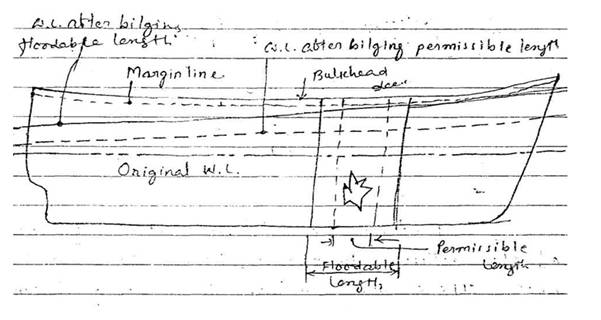Question
Explain what is meant by permissible length
of compartment in passenger ship, Describe how the
position of bulkhead is determined
Describe briefly the significance of the
factor of subdivision

Permissible length of a compartment is the maximum
length of the ship at any point that can be flooded without causing immersion
of margin line by sink age, heel or trim, that is less
than that of with floodable length.
As shown in the figure the margin line is a line 76mm
below the bulkhead deck at side.
If the margin line immersion caused by sink age, heel
or trim takes place then the ship is said to be foundered.
Permissible length is always less than floodable
length of a compartment.
Describe how the position of bulkhead is determined.
The subdivision of the ship by a minimum no of
transverse watertight bulkhead which reduces the possibility of sinking when
this vessel is bilged in the event of a reasonable amount of damage.
The vessel may also have longitudinal bulkhead that
contribute to subdivision.
By word reasonable amount of damage means that in case
of vessel meets a damage that can be divided in 3 dimensional sides of her.
These sides are
vertical. Keel to margin line.
Transverse. One
fifth of the breadth from the side.
Longitudinal. Variable
but not greater than 10.7m.
So the selection of a compartment of permissible length
must be such that if the ship meets with a damage in
either or a combination of sides, she must be capable of remaining afloat after
this damage.
Another important aspect of subdivision of the ship is
to maintain stability in damaged condition. The ship must therefore have
sufficient stability to withstand the damage and remain stable. Such that the GM in the bilged condition must be positive.
Where there is unsymmetrical flooding the angle of
heel is not to exceed 7degree and margin line is not to be immersed.
Longitudinal bulkhead may be included as contributing to
subdivision of passenger ships as long as they are inboard of 1/5th
of the breadth of the ship however if the side compartment is damaged it may
create sever list. such a list must not exceed
15degree at any time and must be reduced to maximum of 7degree within 15
minutes
This may be accomplished by an automatic cross
flooding system.
Factor of subdivision (FS).
Factors of subdivision depends upon the length of the
ship and a criterion of service numeral or more simply criterion numeral. This
numeral represents the criterion of service of the ship and takes account of
the number of passengers, the volumes of the machinery and accommodation spaces
and the total ship volume. It decreases in a regular and continuous manner with
the ship length and factors related to whether the ship carries predominantly
cargo or passengers. Broadly, the factor of subdivision ensures that one, two
or three compartments can be flooded before the margin line is immersed leading
to what are called one-, two- or three-compartment ships. That is, compartment
standard is the inverse of the factor of subdivision. In general terms the
factor of subdivision decreases with length of ship and is lower for passenger
ships than cargo ship.
This is the factor of subdivision. It can range in value
from 0.50 to a maximum of 1.00. The 1.00 value signifies that very few passengers
are being carried on board. The 0.50 value signifies that a very large number
of passengers are being carried on the ship. By using the following formula, FS
is used to determine the permissible length ordinates
FL ordinates X Fs = PL ordinates.
Factors of subdivision is the ratio of permissible
length of a compartment to the floodable length
This is a kind of safety factor which gives that extra
length to the compartment which will sustain the reasonable amount of damage
and remain afloat.
Factor of subdivision depends upon
The extent to which the vessel is a passenger ship
The length of the ship.